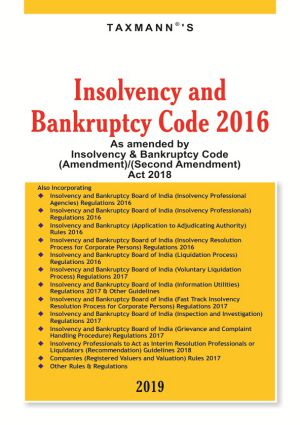Salient Features of Insolvency and Bankruptcy Code 2016
- Blog|Insolvency and Bankruptcy Code|
- 3 Min Read
- By Taxmann
- |
- Last Updated on 1 March, 2022
Following are the key features of the Insolvency and Bankruptcy Code 2016:
1. Resolution of Insolvency:
The Insolvency and Bankruptcy Code, 2016 lays down the separate insolvency resolving procedures for companies, individuals as well as partnership companies. It is possible to initiate the procedure either by the creditors or the debtors. The code lays down a maximum time period for completing the insolvency resolution procedure for individuals and corporates. In the case of a company, the procedure must be fully completed in one hundred and eighty days, which can later be stretched by ninety days only when a large percentage of creditors permit or agree. On the other hand, in the case of start-ups (aside to the partnership companies), small organizations as well as other organizations (having less than Rs 1 crore worth of assets), the resolution procedure would be fulfilled within a period of ninety days of initiating the required that can be further stretched by as many as 45 days.
2. Regulator of Insolvency:
The Code lays down that the Insolvency and Bankruptcy Board of India shall oversee the proceedings related to insolvency in the nation and also regulate all the organizations that have been registered by the board. The Insolvency and Bankruptcy Board shall consist of ten members, which would also include the representatives of the Law and Finance ministries as well as the RBI (Reserve Bank of India).
3. Licensed Insolvency Professionals:
The management of insolvency procedures shall be done by licensed insolvency professionals. They would also exercise control on the debtor’s assets at the time of the insolvency procedure.
4. Insolvency and Bankruptcy Adjudicator:
The Code has introduced two distinct tribunals for overseeing the procedure resolving insolvency, for companies and individuals. These are (i) the National Company Law Tribunal for organizations and Limited Liability Partnership companies; as well as (ii) the Debt Recovery Tribunal for overseeing insolvency resolution for individuals as well as partnership firms.
5. Procedure:
An insolvency plea is given to the authority that adjudicates (incorporate debtor’s case it is NCLT) by operation or financial creditors or the corporate debtor. The plea can be accepted or rejected in a maximum time period of fourteen days. In case the plea gets acceptance then the tribunal will have to quickly appoint an IRP or Insolvency Resolution Professional for drafting a plan of resolution within a period of 180 days (that can be extended by ninety days). Following this, the court would initiate the process of resolving corporate insolvency. For that particular period, the company’s directors shall remain suspended whereas the promoters shall have no say in the company management. The Insolvency Resolution Professional can seek help of the management of the company for handling everyday operations. In case the CIRP is unable to revive the organization, then the process of liquidation shall be initiated.
6. Amendments:
Certain individuals are prohibited from providing any plan of resolution in case there are any defaults. Hence, wilful defaulters, management, or promoters of the company in case there is any non-performing outstanding debt for more than a year, as well as directors who have been disqualified cannot submit any plan. Apart from this, the bill also places a restriction on the selling of a defaulter’s property to any such individuals at the time of liquidation.
Related Articles:
Disclaimer: The content/information published on the website is only for general information of the user and shall not be construed as legal advice. While the Taxmann has exercised reasonable efforts to ensure the veracity of information/content published, Taxmann shall be under no liability in any manner whatsoever for incorrect information, if any.

Taxmann Publications has a dedicated in-house Research & Editorial Team. This team consists of a team of Chartered Accountants, Company Secretaries, and Lawyers. This team works under the guidance and supervision of editor-in-chief Mr Rakesh Bhargava.
The Research and Editorial Team is responsible for developing reliable and accurate content for the readers. The team follows the six-sigma approach to achieve the benchmark of zero error in its publications and research platforms. The team ensures that the following publication guidelines are thoroughly followed while developing the content:
- The statutory material is obtained only from the authorized and reliable sources
- All the latest developments in the judicial and legislative fields are covered
- Prepare the analytical write-ups on current, controversial, and important issues to help the readers to understand the concept and its implications
- Every content published by Taxmann is complete, accurate and lucid
- All evidence-based statements are supported with proper reference to Section, Circular No., Notification No. or citations
- The golden rules of grammar, style and consistency are thoroughly followed
- Font and size that’s easy to read and remain consistent across all imprint and digital publications are applied




 CA | CS | CMA
CA | CS | CMA
